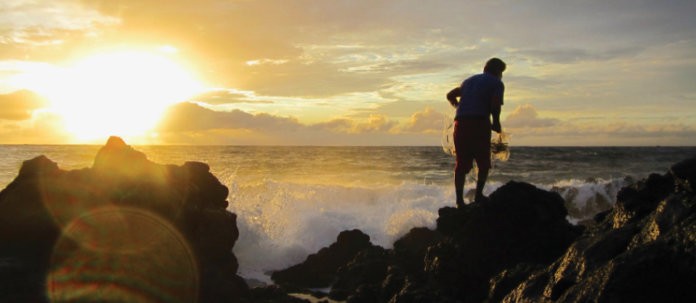August 1, 2021

By Scott Crawford
The residents of Kīpahulu live off the grid.
They generate their own power, obtain water through catchment systems and streams, and grow, gather, raise and catch their own food. The only public utility servicing the area is Hawaiian Telcom. It is a quiet, self-sufficient lifestyle.
Located on the southeast side of Maui, about 10 miles southwest of Hāna town, the moku (district) of Kīpahulu is a traditional fishing, farming, hunting, and gathering area that sustained a substantial Native Hawaiian population for centuries.
Yet despite its remote location and quiet lifestyle, the moku attracts more than one million visitors every year.
In order to preserve the area’s culture and customs, in 1995, Uncle Mike Minn, Uncle John Lind, and Auntie Tweetie Lind founded the Kīpahulu ʻOhana. This grassroots Hawaiian nonprofit organization is dedicated to ensuring the cultural sustainability of Kīpahulu Moku. Their goal is to enable families in the community to work together to not just preserve, but to enhance their traditional cultural practices.

A key strategy to accomplish this is through culturally based agricultural and resource management projects, mauka to makai.
Their flagship project is Kapahu Living Farm, a traditional Hawaiian wetland taro farm, managed through a partnership agreement with Haleakalā National Park. Ancient loʻi kalo have been restored on the farm, and other canoe plants like ulu and maiʻa are also grown. Poi and other products grown and produced on the farm are processed at their certified kitchen for distribution in the community. They also have an educational component, and host schools and community groups at the farm.
As part of their ahupuaʻa approach to resource management, Kīpahulu ʻOhana also focuses on shoreline and near-shore stewardship. In 2012, they developed the Kīpahulu Moku Mālama i Ke Kai Community Action Plan with input from fishermen, cultural practitioners, scientists, and other community members.

There is growing concern about unregulated and over-harvesting of marine resources – including harvesting undersized individuals, harvesting species out of season, or harvesting during spawning times – which leads to decreased productivity and diversity.
Over the years, unsustainable harvesting has resulted in the decline of marine resources and the community became increasingly frustrated with the ineffectiveness of state-level management and one-size-fits-all rules that don’t always account for local cultural and ecological factors.
In response, Kīpahulu ʻOhana proposed the designation of Kīpahulu Moku as a Community Based Subsistence Fishing Area (CBSFA).
Hawaiʻi’s CBSFA designation formally recognizes local communities as valued partners in protecting natural resources and reaffirms and protects traditional and customary practices for subsistence and culture. CBSFAs are place-based, community-driven, and are the only type of fishery or marine management designation in Hawaiʻi that protects traditional subsistence practices and Hawaiian lifestyles that depend on these resources in addition to protecting the fish population.
CBSFA designation and a collaborative management plan can help change fishing behavior, allowing fish populations to stabilize and recover. Which, in turn, will ensure that future generations also have access to marine resources.
Once this status is approved, conservation measures for Kīpahulu will be enforceable at the state level. However, Kīpahulu ʻOhana’s focus is on education and outreach, so fishermen understand the reasons behind them and the importance of lawaiʻa pono practices.
For years, Kīpahulu ʻOhana has been conducting outreach activities to gather input and grow support for CBSFA designation. In October 2019, they submitted their Kīpahulu Moku CBSFA Proposal and Management Plan to the State Division of Aquatic Resources.
The proposal includes management recommendations such as expanding the seasonal closure for moi and ula by two months, as recent studies indicate active spawning beyond the current season. It also recommends adding a maximum size along with the existing state minimum size for key species to protect “prime spawners” who contribute to the reproduction of those fish populations and suggests creating a puʻuhonua, or a no-fish zone, to allow diverse species to spawn and reproduce. The proposal also encourages lawaiʻa to move from a “trophy fishing” mindset of biggest is best, and to focus instead on lawaiʻa pono – feeding their families now and in the future.
A founding member of the Maui Nui Makai Network (mauinui.net), Kīpahulu ʻOhana, along with other network members, is actively supporting other rural communities in Maui Hikina (East Maui), from Keʻanae to Kaupō, to develop their own makai management plans and programs. By working together, communities across East Maui are moving towards the development of a regional makai management strategy.
For more information about the Kīpahulu Moku CBSFA, including the full rules proposal and management plan, go to kipahulu.org/cbsfa.
Scott Crawford has served as executive director with Kīpahulu ʻOhana for the last 20 years, supporting traditional Hawaiian agriculture, shoreline and forest management. He works with East Maui grassroots Hawaiian organizations to protect and manage precious lands and shorelines in East Maui for traditional subsistence lifestyles, from mauka to makai.